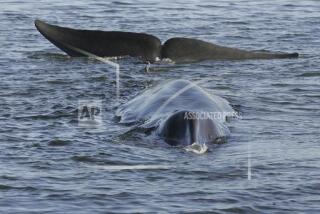Salmon ‘Aquaculture’ Revives Troubled Norway Fish Industry
- Share via
OSLO — Mass farming of the coveted Atlantic salmon and its swift transport to dining tables around the world is giving Norway’s fishermen a new lease on life.
“Salmon breeding is becoming big business, attracting more and more investors,” Fisheries Minister Thor Listau said.
Production of salmon and the smaller sea trout reached 30,000 tons last year, more than double the 1982 figure, and Europe, the United States and Japan are crying out for more of the Norwegian delicacies.
Listau said the future of the fishing industry, in deep trouble for many years due to the depletion of cod and herring stocks, is looking brighter because of aquaculture.
With 1,656 miles of coastline, Norway was a predominantly fishing nation until the discovery of North Sea oil in the late 1960s, and its fishermen are well equipped to handle fish and the difficulties of commercial mass production.
Threat of Depleted Stocks
Listau said many fishermen whose livelihoods were threatened by depleted stocks and stringent fishing quotas had switched to aquaculture with impressive results.
From planning a fish farm to killing the first salmon takes about three years, and while 50% state loans have eased the initial problems, farmers are forced to take out hefty bank overdrafts to see them through the difficult first period.
After two years of careful breeding in one of the 450 farms along the west coast, the farmer can kill his first salmon, weighing between 6.6 and 8.8 pounds, which has been fattened in the sparkling northern Atlantic.
The fish is transported by refrigerated truck and ship to European markets and by air to the United States and Japan. Farmers say the salmon can reach exclusive Texas restaurants just 48 hours after it is killed.
Professor Arne Jensen of Norway’s Institute of Marine Biochemistry says about 100,000 tons of salmon a year could be produced by 1990.
If the fjords, which total about 11,900 miles in length, were used, the figure could leap to 300,000 tons annually.
Environmental Issues
But Listau warned that important environmental issues would have to be settled before commercialization of Norway’s fjords, which are renowned for their beauty.
Aquaculture has made great strides in Norway over the past three decades, and become popular in schools and universities. Now the government is keen to study the potential of a new way of breeding salmon and trout: sea grazing.
This invoves keeping smolt--young salmon and trout--in pens in the fjords before freeing them to swim in the Atlantic where they feed on plankton.
More to Read
Sign up for Essential California
The most important California stories and recommendations in your inbox every morning.
You may occasionally receive promotional content from the Los Angeles Times.













